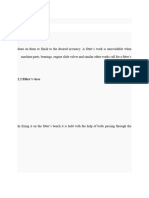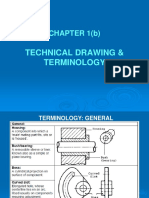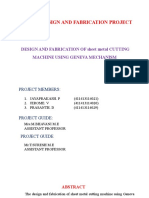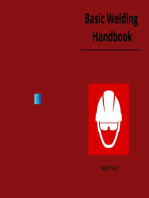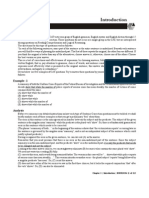Shearing
Shearing
Uploaded by
fahadCopyright:
Available Formats
Shearing
Shearing
Uploaded by
fahadCopyright
Available Formats
Share this document
Did you find this document useful?
Is this content inappropriate?
Copyright:
Available Formats
Shearing
Shearing
Uploaded by
fahadCopyright:
Available Formats
Key
Q NO 1 Write a brief note on Electric resistance welding? (50 Marks)
Answer: -
ELECTRIC RESISTANCE WELDING
Electric resistance welding, either spot welding or seam welding, is typically used to
join thin sheet metal components during the manufacturing process.
SPOT WELDING
Two copper electrodes are held in the jaws of the spot-welding machine, and the
material to be welded is clamped between them. Pressure is applied to hold the electrodes
tightly together and electrical current flows this pressure is held after the current stops flowing
long enough for the metal to solidify. The amount of current, pressure, and dwell time are all
carefully controlled and matched to the type of material and the thickness to produce the
correct spot welds.
SEAM WELDING
Rather than having to release the electrodes and move the material to form a series
of spot welds, a seam welding machine is used to manufacture fuel tanks and other
components where a continuous weld is needed. Two copper wheels replace the bar-shaped
electrodes. The metal to be welded is moved between them, and electric pulses create spots
of molten metal that overlap to form the continuous seam.
Q NO 2 Write a brief note on squaring shear and explain its distinct operation?
(20+30 Marks)
SQUARING SHEAR
The squaring shear provides the airframe technician with a convenient means of
cutting and squaring sheet metal. Available as a manual, hydraulic, or pneumatic model, this
shear consists of a stationary lower blade attached to a bed and a movable upper blade
attached to a crosshead.
Two squaring fences, consisting of thick strips of metal used for squaring metal
sheets, are placed on the bed. One squaring fence is placed on the right side and one on the
left to form a 90° angle with the blades. A scale graduated in fractions of an inch is scribed
on the bed for ease in placement.
To make a cut with a foot shear, move the upper blade down by placing the foot on
the treadle and pushing downward. Once the metal is cut and foot pressure removed, a
spring raises the blade and treadle. Hydraulic or pneumatic models utilize remote foot pedals
to ensure operator safety. The squaring shear performs three distinctly different operations:
1. Cutting to a line
2. Squaring
3. Multiple cutting to a specific size
CUTTING TO A LINE
When cutting to a line, place the sheet on the bed of the shears in front of the cutting
blade with the cutting line even with the cutting edge of the bed. To cut the sheet with a foot
shear, step on the treadle while holding the sheet securely in place.
SQUARING
Squaring requires several steps. First, one end of the sheet is squared with an edge
(the squaring fence is usually used on the edge). Then, the remaining edges are squared by
holding one squared end of the sheet against the squaring fence and making the cut, one
edge at a time, until all edges have been squared.
MULTIPLE CUTTING
When several pieces must be cut to the same dimensions, use the backstop, located
on the back of the cutting edge on most squaring shears. The supporting rods are graduated
in fractions of an inch and the gauge bar may be set at any point on the rods. Set the gauge
bar the desired distance from the cutting blade of the shears and push each piece to be cut
against the gauge bar. All the pieces can then be cut to the same dimensions without
measuring and marking each one separately.
You might also like
- Project Report Circular SawDocument31 pagesProject Report Circular SawPrince Kumar54% (28)
- CVC 302 ManualDocument176 pagesCVC 302 ManualMazda62006100% (5)
- Cbe-241rev Quad Processing MachineDocument12 pagesCbe-241rev Quad Processing MachineVigneshMurugesh ANo ratings yet
- Fabrication of Scotch Yoke Mechanism HacksawDocument76 pagesFabrication of Scotch Yoke Mechanism Hacksawkarthik keyanNo ratings yet
- DOCUMENTDocument48 pagesDOCUMENTTirupati Reddy GuduriNo ratings yet
- Notes On Module 7Document38 pagesNotes On Module 7raj mohanNo ratings yet
- First Year Lab RecordDocument54 pagesFirst Year Lab Recordjk4449555No ratings yet
- Ews-Itws Lab ManualDocument167 pagesEws-Itws Lab ManualNetaji GandiNo ratings yet
- 44-Slider Crank Mechanism Using HacksawDocument15 pages44-Slider Crank Mechanism Using HacksawsathishNo ratings yet
- Engineering Workshop: Laboratory ManualDocument29 pagesEngineering Workshop: Laboratory Manualeklavya aditya patelNo ratings yet
- Ews-Itws Lab ManualDocument168 pagesEws-Itws Lab Manualsrinivasallam_259747No ratings yet
- 5 Essentials or Parameters of WeldingDocument28 pages5 Essentials or Parameters of Weldingryam0312001No ratings yet
- BWP PDFDocument70 pagesBWP PDFSumit KumarNo ratings yet
- Power ScrewDocument6 pagesPower ScrewDeepak KrishnanNo ratings yet
- ALL Experiments MT-2Document16 pagesALL Experiments MT-2rahulyadav9944No ratings yet
- Project ReportDocument24 pagesProject ReportBoopathyNo ratings yet
- The Bench Work Tools and Its UsesDocument24 pagesThe Bench Work Tools and Its Usespin73196No ratings yet
- Chap 1-Dwg TerminologyDocument32 pagesChap 1-Dwg TerminologyZhafri SyazwiNo ratings yet
- 2 Workshop Manual Word FileDocument61 pages2 Workshop Manual Word FileflamexytofficialNo ratings yet
- Synopsis Pedal HacksawDocument13 pagesSynopsis Pedal Hacksawbalbir100% (1)
- Arc Welding ProjectDocument11 pagesArc Welding ProjectLeahNo ratings yet
- DV03PUB18 Study GuideDocument5 pagesDV03PUB18 Study Guidesssf-dobojNo ratings yet
- Butt Joint Upload 1Document6 pagesButt Joint Upload 1Aminda FernandoNo ratings yet
- WeldingDocument70 pagesWeldingDianne S BajanaNo ratings yet
- Project Report ON "Resistance Spot Welding": Department of Mechanical Engineering Gitam University VisakhapatnamDocument32 pagesProject Report ON "Resistance Spot Welding": Department of Mechanical Engineering Gitam University VisakhapatnamAbhinashNo ratings yet
- Basic Marking Out and Measuring InstrumentsDocument70 pagesBasic Marking Out and Measuring Instrumentsbonganishiba594No ratings yet
- Trash Bag and Sand CastingDocument25 pagesTrash Bag and Sand CastingBirukNo ratings yet
- Tool DesignDocument48 pagesTool DesignPAVIN ENGGNo ratings yet
- Project Report Circular SawDocument31 pagesProject Report Circular Sawanon_510437847100% (2)
- Fitting ToolsDocument14 pagesFitting ToolsManoj Lohumi100% (2)
- Projection Welding AssignmentDocument3 pagesProjection Welding AssignmentDawood AbdullahNo ratings yet
- CarpentryDocument35 pagesCarpentrySadasiva Rao TNo ratings yet
- Power Point Essentials of WeldingDocument53 pagesPower Point Essentials of WeldingWilmerNo ratings yet
- Metal Joining Processes: List Types of Welding, Description With Sketches ofDocument19 pagesMetal Joining Processes: List Types of Welding, Description With Sketches ofeldhosekjnitNo ratings yet
- 6 Bending FormingDocument72 pages6 Bending FormingNarendrareddy RamireddyNo ratings yet
- Mec 126 Lecture NoteDocument11 pagesMec 126 Lecture Notemboniface763No ratings yet
- Fittings and TolerancesDocument2 pagesFittings and TolerancesdawitNo ratings yet
- Bandsaw Blade Welder 2Document7 pagesBandsaw Blade Welder 2ejmoreno779No ratings yet
- LV and MV Construction StandardsDocument23 pagesLV and MV Construction StandardssemajamesNo ratings yet
- For Wood Cutter MachineDocument19 pagesFor Wood Cutter MachineRahul Rajput100% (1)
- Sheet Metal FormingDocument5 pagesSheet Metal FormingScribdd3r100% (2)
- GR 11 ReportDocument14 pagesGR 11 ReportVanessa HadJeanxNo ratings yet
- Sheet Metal Cutting Using Geneva MechanismDocument27 pagesSheet Metal Cutting Using Geneva MechanismsingamNo ratings yet
- Las Smaw Q3-W1-3Document13 pagesLas Smaw Q3-W1-3Daryl TesoroNo ratings yet
- Welding ActivityDocument4 pagesWelding ActivityRobert John Lico-anNo ratings yet
- Aircraft Metal Structural RepairDocument5 pagesAircraft Metal Structural RepairKatrina VilladiegoNo ratings yet
- Rivets, Welded Joints, Pin JointsDocument69 pagesRivets, Welded Joints, Pin JointsSiddharth KotechaNo ratings yet
- Steps For WeldingDocument6 pagesSteps For WeldingEmoxie X - StabyielzNo ratings yet
- Maurya Motors AssignmentDocument21 pagesMaurya Motors Assignmentshubham kumar mehtaNo ratings yet
- Shearing ToolsDocument21 pagesShearing Toolsメルヴリッ クズルエタNo ratings yet
- Miter Joint: Non-Perpendicular JointsDocument1 pageMiter Joint: Non-Perpendicular JointsMohit BauskarNo ratings yet
- 6) Hacksaw Used in FittingDocument3 pages6) Hacksaw Used in FittingKrako TramNo ratings yet
- Resistance Seam WeldingDocument31 pagesResistance Seam Weldingaiman87_uitm100% (3)
- Chapter 4 Die DesignDocument102 pagesChapter 4 Die DesignTamirat Nemomsa100% (3)
- Structural Framing Accessory Products Data SheetDocument3 pagesStructural Framing Accessory Products Data SheetTito MuñozNo ratings yet
- Welding StepsDocument17 pagesWelding StepsSakhawat AliNo ratings yet
- Manufacturing Method of Cotter JointDocument10 pagesManufacturing Method of Cotter JointAkshay Jadhav33% (6)
- Fitting Shop Lab ManualDocument16 pagesFitting Shop Lab ManualHuzaifaNo ratings yet
- Inspection of Sheet Metal Work Riveting 2Document6 pagesInspection of Sheet Metal Work Riveting 2raj mohanNo ratings yet
- Checklist of Community ProcedureDocument8 pagesChecklist of Community ProcedureSaima ParveenNo ratings yet
- Agile DevelopmentDocument31 pagesAgile Developmentbright.keswaniNo ratings yet
- Ashley Goff EDU/HUS 325 Social Studies Activity Project "Community"Document14 pagesAshley Goff EDU/HUS 325 Social Studies Activity Project "Community"api-242664373No ratings yet
- Self-Concept and Self-Esteem in Adolescents NASSP Feb 07 PDFDocument5 pagesSelf-Concept and Self-Esteem in Adolescents NASSP Feb 07 PDFAndra AndruNo ratings yet
- 03 - REIT - May 27Document4 pages03 - REIT - May 27MAUREEN BAN-EGNo ratings yet
- Writing E8 (Unit 7-12)Document17 pagesWriting E8 (Unit 7-12)Linh Nguyễn KhánhNo ratings yet
- Industry Day - Code 70 Slides 2.25.14Document11 pagesIndustry Day - Code 70 Slides 2.25.14N TNo ratings yet
- Photosynthesis TestDocument4 pagesPhotosynthesis TestLester Eslava OrpillaNo ratings yet
- Pharmacognosy Chapter 7 Traditional System of Medicine Ayurvedic Preparations NotesDocument13 pagesPharmacognosy Chapter 7 Traditional System of Medicine Ayurvedic Preparations NotesAbhishek palNo ratings yet
- Impact of Online Advertising On Consumers Buying Behaviour: A Study With Reference To Karkala TalukDocument5 pagesImpact of Online Advertising On Consumers Buying Behaviour: A Study With Reference To Karkala TalukbobNo ratings yet
- MOD NAV 101B 12 r.3Document4 pagesMOD NAV 101B 12 r.3Christian Felix GuevarraNo ratings yet
- DPP 02 Chemical Bonding JH Sir-4165 PDFDocument3 pagesDPP 02 Chemical Bonding JH Sir-4165 PDFPrabhakar BandaruNo ratings yet
- International Journal of NeuropsychotherapyDocument103 pagesInternational Journal of NeuropsychotherapyJOSÉ DAVID SALCEDO CASTRONo ratings yet
- G+2 NewDocument1 pageG+2 New39 - Deep MandokarNo ratings yet
- Tesco Plans To Open Las Vegas SupermarketsDocument2 pagesTesco Plans To Open Las Vegas SupermarketsHuong NguyenNo ratings yet
- Animal Behavior An Evolutionary Approach John Alcock Download PDFDocument64 pagesAnimal Behavior An Evolutionary Approach John Alcock Download PDFaduchheed100% (2)
- Dickson LookingGilgamesh 2007Document13 pagesDickson LookingGilgamesh 2007klora juisNo ratings yet
- SM1001902Document110 pagesSM1001902Rahul barodNo ratings yet
- Example - 1: Chapter 1 - Introduction - BMM10204 - 1 of 112Document7 pagesExample - 1: Chapter 1 - Introduction - BMM10204 - 1 of 112Sayan DattaNo ratings yet
- Didactic Guide. Verb To BeDocument3 pagesDidactic Guide. Verb To Bejung3232 -No ratings yet
- KTR Kat99pp01 Coupling GuardDocument20 pagesKTR Kat99pp01 Coupling Guardmoorthymech1979100% (1)
- EIA 2004 Exam QuestionsDocument6 pagesEIA 2004 Exam QuestionsSofy AnuraNo ratings yet
- Class04 Chemistry G11 Homework Sep 25-29Document4 pagesClass04 Chemistry G11 Homework Sep 25-29Erin100% (1)
- EC1313 Two Marks Linear Integrated CircuitsDocument11 pagesEC1313 Two Marks Linear Integrated Circuitsmoney_kandan2004No ratings yet
- Swinging CircleDocument2 pagesSwinging CircleNarayana Reddy100% (1)
- Essay On FlexibilityDocument6 pagesEssay On FlexibilityJohn DoeNo ratings yet
- Merging Multimedia, Controls and Plug - Ins WithDocument17 pagesMerging Multimedia, Controls and Plug - Ins Withammu_20130% (1)
- Study Guide Template EDITEDDocument5 pagesStudy Guide Template EDITEDRico EsponillaNo ratings yet
- Presentation 6Document9 pagesPresentation 6Priyotamo NandiNo ratings yet
















